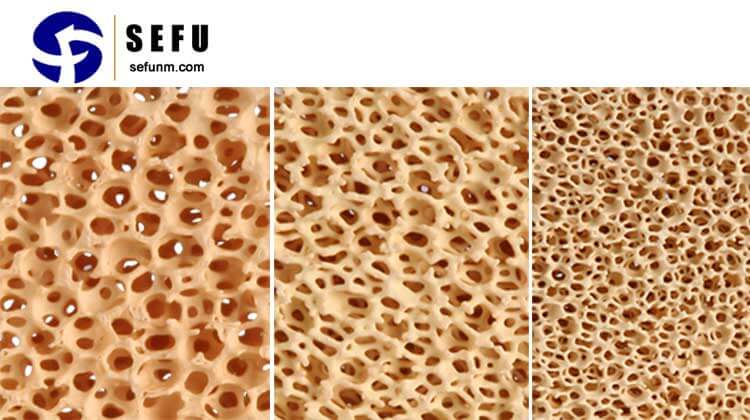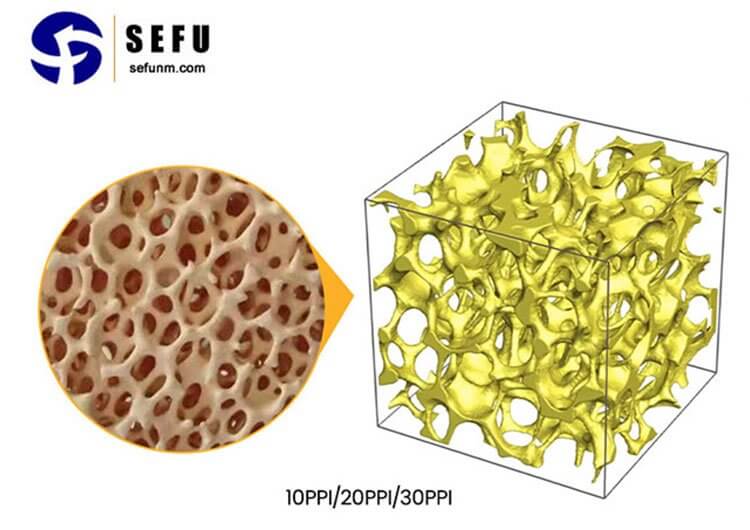Introduction:
Ceramic foam filters are widely used in various industries for the filtration of impurities from molten metals and alloys. The filtration efficiency of these filters is greatly influenced by their pore size and porosity. Understanding the impact of pore size and porosity on filtration efficiency is crucial for optimizing filter performance and achieving high-quality end products. This essay examines how pore size and porosity affect the filtration efficiency of ceramic foam filters and discusses their implications in industrial applications.
Section 1: Pore Size and Its Significance
Pore size is a critical parameter that directly affects the molten metal filtration efficiency of ceramic foam filters. It refers to the size of the void spaces within the filter structure. The selection of an appropriate pore size depends on the size of the impurities to be removed. Filters with smaller pore sizes are effective in capturing smaller particles, while filters with larger pore sizes can accommodate larger particles. The relationship between pore size and filtration efficiency is governed by the principles of size exclusion and depth filtration. Thus, the selection of appropriate pore size is crucial in achieving the desired level of impurity removal while maintaining efficient flow characteristics.

The pore size requirements depend on the specific application and the size distribution of the impurities to be removed. For instance, in the aluminum casting industry, the majority of impurities, such as oxides and inclusions, range from a few micrometers to tens of micrometers in size. Therefore, ceramic foam filters with pore sizes in the range of 10 to 40 pores per inch (PPI) are commonly used to effectively capture these impurities. Fine-grained filters with smaller pore sizes are suitable for applications where finer impurities need to be removed, such as in the semiconductor industry.
The selection of an appropriate pore size involves careful consideration of the impurity size distribution, the flow characteristics of the molten metal, and the specific requirements of the application. Manufacturers and engineers need to evaluate the trade-offs between filtration efficiency, flow rate, pressure drop, and maintenance frequency to determine the optimal pore size for a given application.
Section 2: Size Exclusion Mechanism
The size exclusion mechanism plays a key role in the filtration process of ceramic foam filters. As molten metal passes through the filter, particles larger than the pore size are unable to penetrate the filter structure and are effectively removed. Smaller particles, however, can pass through the filter, reducing the overall filtration efficiency. Therefore, selecting an appropriate pore size is crucial to achieving the desired level of impurity removal.
Section 3: Depth Filtration Mechanism
In addition to size exclusion, the depth filtration mechanism also contributes to the overall filtration efficiency of ceramic foam filters. Porosity, which refers to the volume of void spaces within the filter structure, plays a significant role in this mechanism. Filters with higher porosity provide a larger surface area for impurities to be captured, allowing for increased filtration capacity and improved efficiency.

Section 4: Influence of Pore Size and Porosity on Filtration Efficiency
The relationship between pore size, porosity, and filtration efficiency is complex and depends on various factors, including the type of impurities, the viscosity of the molten metal, and operating conditions. Generally, filters with smaller pore sizes and higher porosity offer higher filtration efficiency for fine particles. However, excessively small pore sizes may result in increased pressure drop and reduced flow rates, limiting their practicality in some applications. Similarly, very high porosity may compromise the mechanical strength of the filter, impacting its durability.
Section 5: Industrial Applications and Optimal Pore Size/ Porosity Selection
Different industrial applications require specific pore sizes and porosities to achieve optimal filtration efficiency. For example, in the aluminum casting industry, ceramic foam filters with pore sizes ranging from 10 to 40 pores per inch (PPI) are commonly used. This range allows for the effective removal of inclusions and oxides, leading to improved casting quality. However, the optimal pore size and porosity may vary depending on the specific alloy, casting method, and desired product characteristics.
Section 6: The Role of Material Properties
Apart from pore size and porosity, material properties such as chemical composition, thermal stability, and mechanical strength also influence the filtration efficiency of ceramic foam filters. The choice of ceramic material should be carefully considered to ensure compatibility with the molten metal and the filtration process. The material should resist chemical reactions, maintain structural integrity at high temperatures, and exhibit sufficient mechanical strength to withstand the flow of molten metal.
Section 7: Advances in Pore Size Control and Porosity Optimization
The optimization of pore size and porosity in ceramic foam filters has been the subject of extensive research and development. Advancements in manufacturing techniques have enabled precise control over these parameters, allowing for enhanced filtration performance and expanded applications. Innovations in pore size control and porosity optimization have opened up new possibilities for tailoring ceramic foam filters to specific industrial requirements.
One significant advancement in pore size control is the utilization of additive manufacturing techniques, such as 3D printing. This method enables the fabrication of complex filter structures with precise and customizable pore sizes. By adjusting the printing parameters and using suitable printing materials, manufacturers can achieve filters with tailored pore size distributions to target specific impurity ranges. This level of control allows for the optimization of filtration efficiency and the removal of impurities of varying sizes.
Template-based approaches are another avenue for pore size control and porosity optimization. In this method, a sacrificial template is used to create the desired pore structure. The template material is coated with a ceramic slurry or infiltrated with molten ceramic, and subsequently, the template is removed, leaving behind the desired pore network. This technique allows for the creation of filters with uniform pore sizes and controlled porosity.
Advancements in material formulations have also contributed to improved pore size control and porosity optimization. Researchers have explored the use of different ceramic materials and their combinations to achieve desired filtration characteristics. By modifying the composition and particle size distribution of the ceramic materials, manufacturers can fine-tune the pore size and porosity to meet specific filtration requirements. Additionally, incorporating additives or modifiers into the ceramic matrix can further enhance the properties of the filters, such as thermal stability, mechanical strength, and chemical resistance.
Multi-layered filter structures have emerged as a promising approach for pore size control and porosity optimization. By stacking layers of ceramic foam filters with varying pore sizes and porosities, filtration efficiency can be enhanced. This design allows for the capture of impurities at different stages, improving the overall filtration performance. Furthermore, multi-layered filters provide flexibility in adapting to changing process conditions or impurity characteristics.
The optimization of pore size and porosity also involves advanced characterization techniques to evaluate filter performance. Researchers employ various methods such as microscopy, image analysis, and flow modeling to assess the pore size distribution, porosity, and fluid dynamics within the filter structure. These analyses help in understanding the relationships between pore size, porosity, and filtration efficiency, allowing for informed design decisions and further advancements.
The continued research and development in pore size control and porosity optimization hold promising prospects for the future of ceramic foam filters. Efforts are focused on achieving even finer control over pore size distribution, exploring new materials and composites, and developing advanced manufacturing techniques. These advancements aim to improve filtration efficiency, enhance mechanical strength, increase thermal stability, and expand the range of applications for ceramic foam filters.
Section 8: Characterization and Evaluation of Filtration Efficiency
To assess the filtration efficiency of ceramic foam filters, various characterization techniques are employed. These include particle retention tests, pressure drop measurements, and analysis of filtered samples. These evaluations help determine the effectiveness of the filters in removing impurities, as well as their resistance to clogging and pressure loss.
Section 9: Future Directions and Potential Solutions
Continued research and development efforts are focused on addressing the challenges associated with pore size and porosity in ceramic foam filters. Emerging technologies and materials offer potential solutions, such as advanced pore size control techniques, novel ceramic formulations, and multi-layered filter structures. These advancements aim to improve filtration efficiency, increase mechanical strength, and expand the range of applications for ceramic foam filters.
Conclusion
Pore size and porosity play crucial roles in determining the filtration efficiency of ceramic foam filters. The selection of appropriate pore size and porosity is essential for achieving the effective removal of impurities from molten metals and alloys. The interplay between size exclusion and depth filtration mechanisms determines the filter’s ability to capture particles of different sizes. By optimizing pore size, porosity, and material properties, manufacturers can tailor ceramic foam filters to meet the specific requirements of various industrial applications.
Future advancements in manufacturing techniques and material development hold promise for further enhancing the performance of ceramic foam filters. Fine-tuning pore size and porosity control, along with the exploration of novel materials, will enable the production of filters with improved efficiency, durability, and reliability. As industries continue to seek higher standards of quality and productivity, the understanding and optimization of pore size and porosity will continue to drive progress in the field of ceramic foam filter technology.


